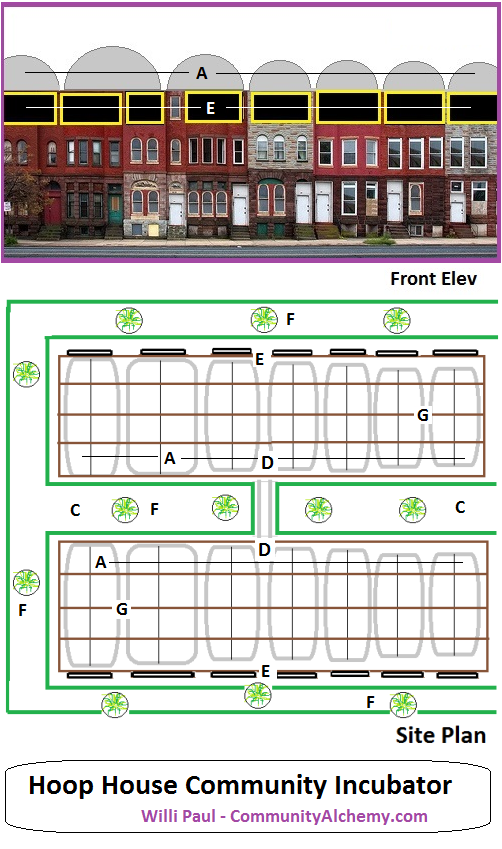Hoop House Community Incubator (HHCI) - Vision for West Baltimore by Willi Paul, Planetshifter.com Design
Hoop House Community Incubator (HHCI) - Vision for West Baltimore by Willi Paul, Planetshifter.com Design
In the neighborhood where much of the violence took place, a third of homes were already vacant and more than half of working-age residents do not have jobs. The median household income is $25,000, less than half the national average. Chain stores are rare: residents rely on expensive little shops that sell groceries through hatches in bulletproof screens. Prices are high because competition is weak: few shopkeepers want to work in such a dangerous neighborhood.
* * * * * * *
Drawing Key for Elevation and Site Plan-
A. Hoop Houses
B. Sky Bridges
C. Share Faire / Play Area
D. Roof-top Gardens
E. Solar Panels
F. Trees
G. Exposed, water-proofed roof joists
* * * * * * *
Introduction –
The Hoop House Community Incubator is envisioned to support a new "Collective Initiation" - a renewal for residents of West Baltimore and other places. HHCI is a multi-stage community revitalization process with the Community as the Hero: the end of the so-called "
Urban Desert." Two adjacent row house buildings become connected and supported by new shared, integrated and consolidated HVAC, water and security systems including solar and roof-top garden technologies. Two often, boarded up residences are crime scenes or victims of arson. The roof-top location of the raised beds, hoop houses and solar arrays support a better security profile.
Permaculture and Transition Movement values are hard working engineers as resilience over-powers racism and hatred:
- Care of the Earth and Care of People
- Localization and Sharing
Keep a Shared "Community Transition Record" (The Stuff of New Rituals and Myths) that can include:
- Lessons learned, trials and successes
- Emerging new holidays
- Songs
- Protest pictures
- Messages from neighbors
- Technical innovation
- Garden yield data
- Recipes
- Dreams
Program Elements -
[ 1. ] Hoop Houses (A) - Hoop Houses are on the former 3rd floor of connected buildings. Some are for soil building - others are for growing food and flowers for sale (rotate)
[ 2. ] Spirit Space for Reflection and Shared Meditation
[ 3. ] DIY Spaces for training, production and sales
[ 4. ] Community Hall for indoor HHCI gatherings
[ 5. ] Child Care
[ 6. ] Tech / Vocation Training Center
[ 7. ] 2 Sky Bridges (B) connect two buildings (units) – center of second and third floors
[ 8. ] Share Faire ground level between buildings (C)
[ 9. ] Roof-top Gardens use raised beds (D)
[ 10. ] Water Strategies:
- Allow rain to water gardens directly
- Capture rain with hoops and drains
- Capture snow melt
- Capture and store condensation
[ 11. ] Solar Panels along front (E)
[ 12. ] Trees along street and play area (F)
[ 13. ] Exposed, water-proofed roof joists (G) remain for structural support and place to attach hoop houses
[ 14. ] 1 Community Bath Room (Compostable Toilets)
[ 15. ] 1 Community Kitchen (compost)
* * * * * * *
"
Imagine harvesting your own healthy salads right through the winter. (You can) move beyond the traditional New England growing season to "start earlier" and "harvest later?" Learn - the process of growing herbs and veggies beyond the standard growing season with cold tolerant / hardy plantings and using season extension structures. Incorporating Permaculture Principle #2 - Catch and Store Energy (using the cold frame to extend the harvest); Principle #3 - Obtain a yield (extended veggies!) and #9 - Use Small and Slow Solutions (a simple, easily built structure)-."

